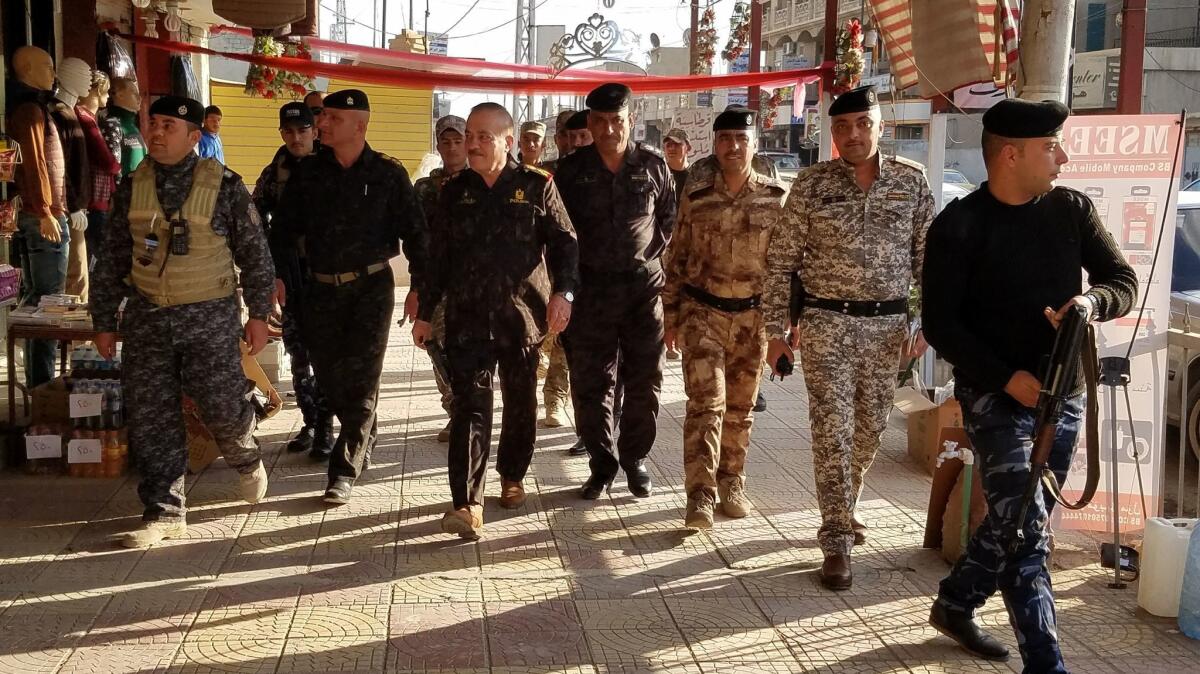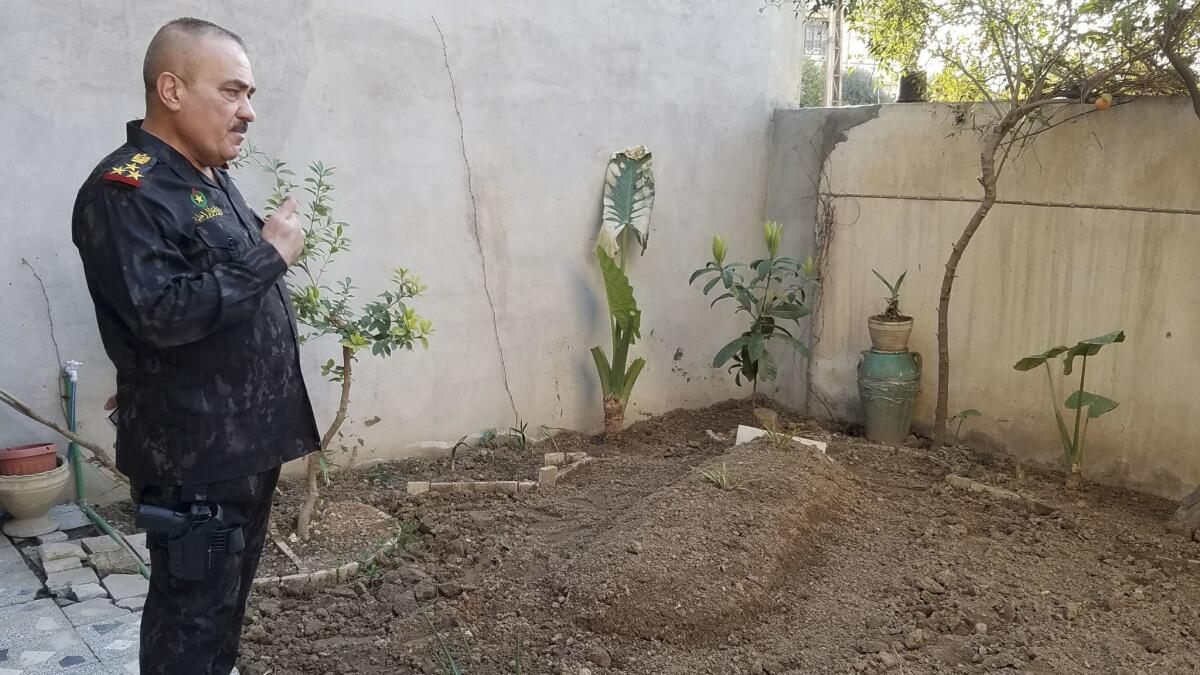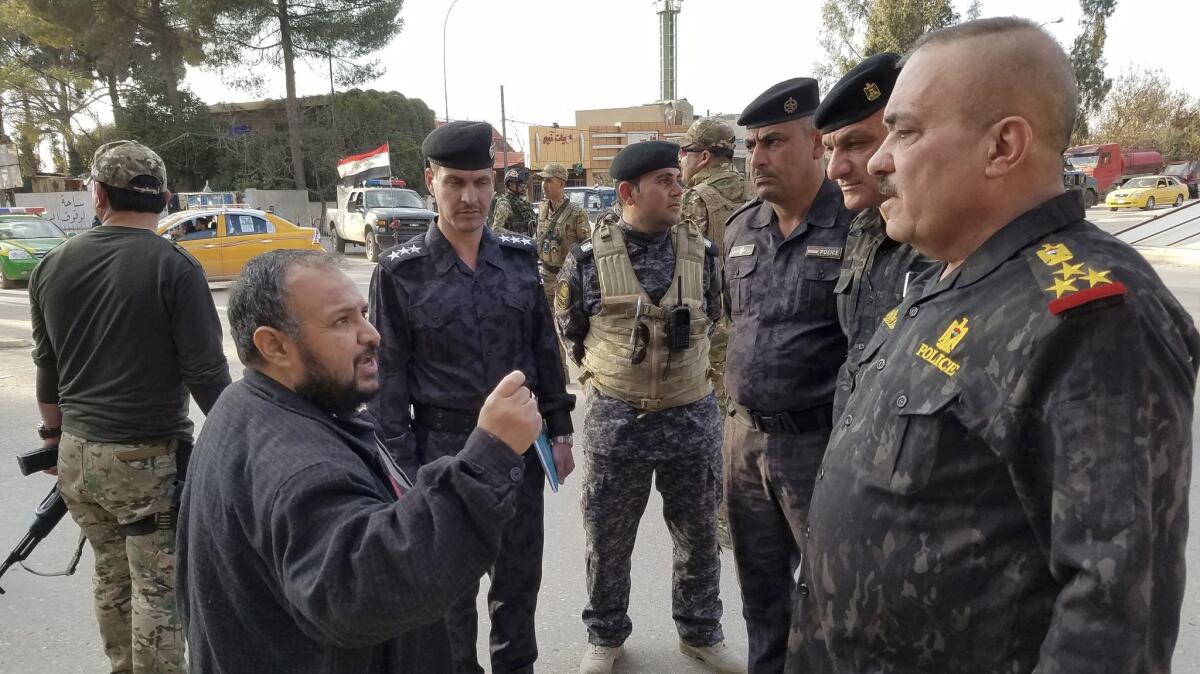East Mosul may be free from Islamic State control, but it’s far from secure

Reporting from Mosul, Iraq — To show how much this embattled city’s east side has recovered since it was freed from Islamic State two months ago, the police chief set out on a tour last week — with two dozen armed guards, one toting a rocket-propelled grenade.
“The reason I have all the security is I was targeted by the terrorists,” said Chief Wathaq Hamdani, 56, conspicuous in his uniform and buzz cut.
He glanced across the bustling street at the ruins of a restaurant destroyed last month by a suicide car bomb. A boom sounded from somewhere in the once wealthy Zahour neighborhood.
“Don’t be afraid,” Hamdani said as he continued on Wednesday, unfazed, insisting the noise was from the Iraqi-led coalition’s artillery.

As Iraqi forces fought street by street for control of Mosul’s west side, authorities on the east side advanced to the next stage of battle: securing and holding areas recaptured from Islamic State.
A steady stream of shoppers stopped to greet the chief as he passed. A young man approached, offering a handful of identification cards he had found: They belonged to Yazidi women, who are an ethnic minority and were probably Islamic State captives. The police accepted the cards and promised to investigate.
Next came an elderly man in a checked head scarf who told the chief he wanted to report his two cars stolen by thieves.
“They were Daesh. They are on the west side,” said Ahmed Abd Merah, 55, using the Arabic acronym for Islamic State.The chief nodded and walked on.
He passed three black police Humvees, guns mounted on top. Hamdani has 10,000 police — roughly the size of the Los Angeles Police Department — patrolling east Mosul, with a population of more than 400,000, along with smaller cities in surrounding Nineveh province.
The province had a population of 3.5 million and 28,000 police before Islamic State seized the area in 2014. Hamdani was working for the Interior Ministry then, but the former soldier had served as chief from 2006 to 2008.
“Before, police had 3,000 cars. Now I have 200. Big problem. I need more cars,” Hamdani said.

The department’s cars and equipment come from the Interior Ministry in Baghdad. The department’s budget of $250 million also comes from the federal government, but is dedicated to paying officers’ $1,000 monthly salaries.
Some of the police who fled when Islamic State arrived have returned, Hamdani said, while others are new trainees. Hamdani expects 1,000 more to arrive this month. Most are motivated by the loss of friends and family. Since the Mosul offensive began in October, 47 Mosul police officers have been killed and 142 others wounded, he said.
“Everyone lost a relative. So it’s motivating them as police to get revenge on Daesh,” Hamdani said.
The Iraqi army is still securing the eastern edge of the Tigris River, but Hamdani hopes to see the city fully patrolled by police soon. Since the east side was declared free in January, police have caught more than 1,000 suspected militants there, he said.

Iraqi forces advancing into west Mosul discovered a train tunnel that had been converted by ISIS militants into a training facility, complete with obstacle course, sleeping quarters and medical station. We toured the site with a member of Iraq’s eme
“Some of them are hiding and some of them are living in the open, pretending no one knows who they are,” he said, pausing to pose for photographs with a young boy.
Often, he said, neighbors tip off police about suspects, whose names are compared to a government database of Islamic State fighters before authorities stage raids to apprehend them.
The chief turned onto a residential street, and waved to a man he knows. Then he stopped by a yellow brick wall, opened a metal gate and walked into the garden of his former home.
A small mound of dirt marked his mother’s temporary grave. About two months ago, she was killed here in a mortar attack. She was 74. Hamdani hopes to move her body to a cemetery on the city’s west side, once it’s freed.
He sat down to chat briefly in the garden. Minutes later, he began to tap his foot nervously. We had been out for about an hour. Now it was nearly dusk, and our tour was about to end.
“You should leave soon,” the chief said. “You have been here a long time.”
Twitter: @mollyhf
ALSO
Bone by bone, Iraqis unearth a mass grave: ‘We will be out there digging until no one is left’
In Mosul, desperate families dodge bullets to reach safety: ‘There’s a sniper here’
The Trump slump? Tourists say they’re scared to visit the United States
More to Read
Sign up for Essential California
The most important California stories and recommendations in your inbox every morning.
You may occasionally receive promotional content from the Los Angeles Times.











